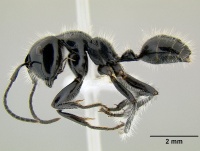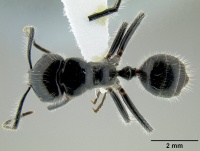Calomyrmex laevissimus
| Calomyrmex laevissimus | |
|---|---|
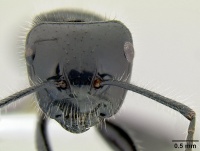
| |
| Scientific classification | |
| Kingdom: | Animalia |
| Phylum: | Arthropoda |
| Class: | Insecta |
| Order: | Hymenoptera |
| Family: | Formicidae |
| Subfamily: | Formicinae |
| Tribe: | Camponotini |
| Genus: | Calomyrmex |
| Species: | C. laevissimus |
| Binomial name | |
| Calomyrmex laevissimus (Smith, F., 1859) | |
| Subspecies | |
| |
Identification
Distribution
Latitudinal Distribution Pattern
Latitudinal Range: 0.789388° to -10.03332996°.
| North Temperate |
North Subtropical |
Tropical | South Subtropical |
South Temperate |
- Source: AntMaps
Distribution based on Regional Taxon Lists
Indo-Australian Region: Indonesia (type locality), New Guinea.
Distribution based on AntMaps
Distribution based on AntWeb specimens
Check data from AntWeb
Countries Occupied
| Number of countries occupied by this species based on AntWiki Regional Taxon Lists. In general, fewer countries occupied indicates a narrower range, while more countries indicates a more widespread species. |

|
Estimated Abundance
| Relative abundance based on number of AntMaps records per species (this species within the purple bar). Fewer records (to the left) indicates a less abundant/encountered species while more records (to the right) indicates more abundant/encountered species. |

|
Biology
Castes
   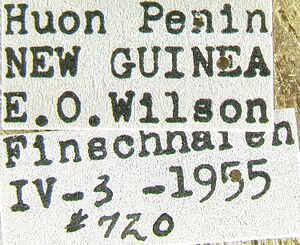
| |
| . | Owned by Museum of Comparative Zoology. |
Images from AntWeb
 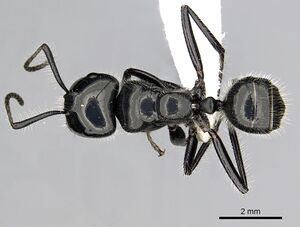  
| |
| Worker. Specimen code casent0249961. Photographer Ryan Perry, uploaded by California Academy of Sciences. | Owned by PSWC, Philip S. Ward Collection. |
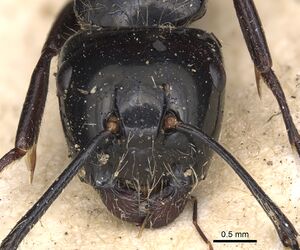    
| |
| Holotype of Calomyrmex laevissimus. Worker. Specimen code casent0901889. Photographer Will Ericson, uploaded by California Academy of Sciences. | Owned by OUM, Oxford, UK. |
Nomenclature
The following information is derived from Barry Bolton's Online Catalogue of the Ants of the World.
- laevissimus. Formica laevissima Smith, F. 1859a: 138 (w.) INDONESIA (Aru Is).
- Type-material: holotype worker.
- [Note: Donisthorpe, 1932c: 452, cites 1w OXUM; (confirmed by Bolton (unpublished notes) 1978.]
- Type-locality: Indonesia: Aru Is., “Aru 28” (A.R. Wallace).
- Type-depository: OXUM.
- [Misspelled as levissima by Roger, 1863b: 10, Dalla Torre, 1893: 238, and others.]
- Mayr, 1897: 435 (q.).
- Combination in Colobopsis: Roger, 1863b: 10;
- combination in Camponotus: Mayr, 1867a: 39;
- combination in Camponotus (Calomyrmex): Mayr, 1897: 435;
- combination in Calomyrmex: Emery, 1895j: 772.
- Status as species: Smith, F. 1860b: 94; Smith, F. 1863: 13; Mayr, 1863: 416; Roger, 1863b: 10; Mayr, 1867a: 39 (redescription); Smith, F. 1871a: 307; Mayr, 1886c: 361; Emery, 1887a: 221; Dalla Torre, 1893: 238; Emery, 1896d: 378 (in list); Mayr, 1897: 435; Viehmeyer, 1912: 8; Viehmeyer, 1913: 147; Viehmeyer, 1914c: 532; Wheeler, W.M. 1919e: 105; Emery, 1925b: 175; Karavaiev, 1929c: 244; Donisthorpe, 1932c: 452; Donisthorpe, 1943d: 459; Chapman & Capco, 1951: 220; Bolton, 1995b: 83.
- Distribution: Indonesia (Aru, Irian Jaya, Sulawesi, Waigeu), Papua New Guinea.
- Current subspecies: nominal plus trochanteralis.
The following notes on F. Smith type specimens have been provided by Barry Bolton (details):
Formica laevissima
Holotype worker in Oxford University Museum of Natural History. Labelled “Aru 28.” Also present in Oxford University Museum of Natural History are two workers from “Wag.” and one each from “Gil. S” and “Bac.”
Description
References
- Bolton, B. 1995b. A new general catalogue of the ants of the world. Cambridge, Mass.: Harvard University Press, 504 pp. (page 83, catalogue)
- Emery, C. 1895l. Die Gattung Dorylus Fab. und die systematische Eintheilung der Formiciden. Zool. Jahrb. Abt. Syst. Geogr. Biol. Tiere 8: 685-778 (page 772, combination in Calomyrmex)
- Klimeš, P., Drescher, J., Buchori, D., Hidayat, P., Nazarreta, R., Potocký, P., Rimandai, M., Scheu, S., Matos-Maraví, P. 2022. Uncovering cryptic diversity in the enigmatic ant genus Overbeckia and insights into the phylogeny of Camponotini (Hymenoptera:Formicidae:Formicinae). Invertebrate Systematics, 36(6), 557-579 (doi:10.1071/is21067).
- Mayr, G. 1867a. Adnotationes in monographiam formicidarum Indo-Neerlandicarum. Tijdschr. Entomol. 10: 33-117 (page 39, combination in Camponotus)
- Mayr, G. 1897. Formiciden aus Ceylon und Singapur. Természetr. Füz. 20: 420-436 (page 435, queen described)
- Smith, F. 1859a. Catalogue of hymenopterous insects collected by Mr. A. R. Wallace at the islands of Aru and Key. [part]. J. Proc. Linn. Soc. Lond. Zool. 3: 132-158 (page 138, worker described)
References based on Global Ant Biodiversity Informatics
- CSIRO Collection
- Donisthorpe, Horace. 1943. The Ants of Waigeu Island, North Dutch New Guinea. The Annals and Magazine of Natural History 11 (10): 433-475.
- Emery C. 1886. Saggio di un catalogo sistematico dei generi Camponotus, Polyrhachis e affini. Memorie della Reale Accademia delle Scienze dell'Istituto di Bologna 5: 363-382
- Emery C. 1887. Catalogo delle formiche esistenti nelle collezioni del Museo Civico di Genova. Parte terza. Formiche della regione Indo-Malese e dell'Australia. [part]. Ann. Mus. Civ. Stor. Nat. 24(4): 209-258.
- Emery, C. "Catalogo delle formiche esistenti nelle collezioni del Museo Civico di Genova. Parte terza. Formiche della regione Indo-Malese e dell'Australia." Annali del Museo Civico di Storia Naturale Giacomo Doria (Genova) (2) 4, no. 24 (1887): 209-258.
- Janda M., G. D. Alpert, M. L. Borowiec, E. P. Economo, P. Klimes, E. Sarnat, and S. O. Shattuck. 2011. Cheklist of ants described and recorded from New Guinea and associated islands. Available on http://www.newguineants.org/. Accessed on 24th Feb. 2011.
- Smith F. 1863. Catalogue of hymenopterous insects collected by Mr. A. R. Wallace in the islands of Mysol, Ceram, Waigiou, Bouru and Timor. Journal and Proceedings of the Linnean Society of London. Zoology 7: 6-48.
- Smith, Fr. "Catalogue of hymenopterous insects collected by Mr. A. R. Wallace in the Islands of Bachian, Kaisaa, Amboyna, Gilolo, and at Dory in New Guinea." Journal of the Proceedings of the Linnean Society of London, Zoology 5 (1860): 93-143.
- Snelling R. R. 1998. Insect Part 1: The social Hymenoptera. In Mack A. L. (Ed.) A Biological Assessment of the Lakekamu Basin, Papua New Guinea, RAP 9. 189 ppages
- Viehmeyer H. 1912. Ameisen aus Deutsch Neuguinea gesammelt von Dr. O. Schlaginhaufen. Nebst einem Verzeichnisse der papuanischen Arten. Abhandlungen und Berichte des Königlichen Zoologischen und Anthropologische-Ethnographischen Museums zu Dresden 14: 1-26.
- Viehmeyer H. 1913. Ameisen aus dem Kopal von Celebes. Stettiner Entomologische Zeitung 74: 141-155.
- Viehmeyer H. 1914. Papuanische Ameisen. Deutsche Entomologische Zeitschrift 1914: 515-535.
- Wheeler W. M. 1919. The ants of Borneo. Bulletin of the Museum of Comparative Zoology 63:43-147.
- Wilson E. O. 1959. Some ecological characteristics of ants in New Guinea rain forests. Ecology 40: 437-447.
